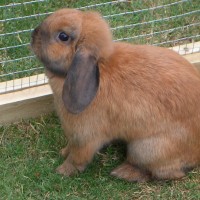 There are numerous proven benefits to keeping pets in terms of child development – pets facilitate a sense of responsibility and help build self-confidence. A child’s social, emotional and cognitive development can all be encouraged by interaction with a pet. However, bringing even a small pet into the family is not a decision that should be made lightly. It first must be a commitment by the parent, not the child, as they will ultimately be responsible for the pet’s welfare.
There are numerous proven benefits to keeping pets in terms of child development – pets facilitate a sense of responsibility and help build self-confidence. A child’s social, emotional and cognitive development can all be encouraged by interaction with a pet. However, bringing even a small pet into the family is not a decision that should be made lightly. It first must be a commitment by the parent, not the child, as they will ultimately be responsible for the pet’s welfare.
Unfortunately, rabbits are typically regarded as a good childhood pet. However, keeping rabbits in a way that does not compromise their welfare and cause behaviour problems involves far more than most people recognize.
Rabbits are prey animals – they are naturally shy, quiet animals who hate being picked up and carried around. Therefore children should be encouraged to interact with them at ground level, and handling should be introduced slowly and carefully so the bunny is not afraid. They should never be scruffed and should not be turned upside down onto their backs – the ‘trance’ that this position seemingly puts them in is actually pure terror as evidenced by the extremely high level of cortisol (a stress hormone) produced by bunnies in this position.
They are also active animals and need plenty of space. Cages and hutches should be regarded as a burrow to shelter in as part of a permanent larger living area, either indoors or outside. Rabbits are most active at dusk and dawn, so lifting them from their hutch into a run for a few hours in the daytime just doesn’t suit their body clocks and instincts. Typical repetitive behaviours (caused by the frustration of thwarted natural behaviour patterns) are frequently seen in animals that live in a cage or hutch with poor environmental enrichment. In addition, rabbits can develop painful skeletal problems if kept permanently caged. The living environment should enable your rabbits to display all of their natural behaviours – running, digging, jumping, hiding and foraging.
Houserabbits can either be restricted to one room or be given the run of the house. Solid flooring is easy to clean but is also slippery, so carpet tiles or runners must be provided. Be aware that conservatories can get too hot in summer (as can the central heating in winter!). Rabbits are quite easy to litter train – the quickest way is to start off with a litter tray in a small area filled with hay (rabbits like to poo and chew at the same time) and gradually increase the time and space they are allowed access to once they are using the tray. Rabbits are attracted to electric wires because they resemble tree roots. In the wild they will chew through roots as they are burrowing, so they need to be plastered into the walls or encased in protective trunking.
Rabbits are social species and naturally live in colonies and never on their own. Recent scientific research has confirmed that rabbits suffer from stress and loneliness if kept alone – they value companionship as much as food. They should be kept in neutered pairs or compatible groups, and not with Guinea Pigs (their behavioural and dietary needs are too different). Houserabbits also need bunny companions as it’s unlikely a human companion will be at home 24/7.
Rabbits should be fed in a way that is as close to their natural diet as possible – mostly grass and hay, which are vital to their digestive, behavioural and dental health. However, a small amount of fresh green leafy veg and an eggcup amount of pellets can also be provided for variation. Contradictory to popular belief, carrots are not an ideal food for rabbits. They are high in sugar and involve gnawing in order to eat, an action that is incompatible with rabbit dentition (rodents have teeth specific to gnawing, rabbits do not!). So if any carrot is going to be given, it needs to be finely sliced to the same length and width as a blade of grass and given in small amounts.
Rabbits live up to 12 years, which may mean they may still be alive when the children leave home – another reminder of the adults in the household to be prepared to commit sufficient time and energy to the rabbits. Rabbits are also not cheap pets – the Rabbit Welfare Association estimate that to keep a pair of rabbits over their lifetime costs around £11,000.
There’s no doubt that bunnies make superb pets and it doesn’t take long for individual personalities to shine through. But it’s also clear by the number of rabbits currently in rescue how many people take on a rabbit without fully understanding their needs. If you’re thinking about introducing rabbits into your life and want more information, or if you are experiencing any problems with your bunnies, please give me a call to see how I can help.